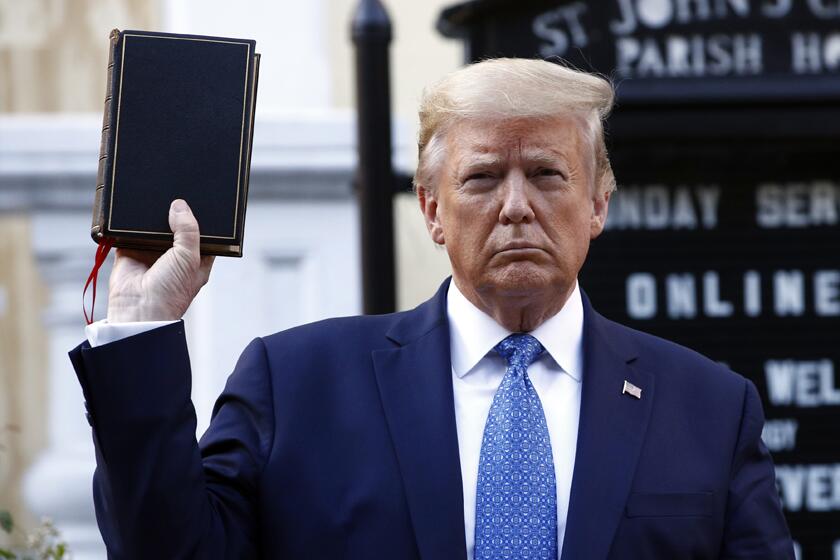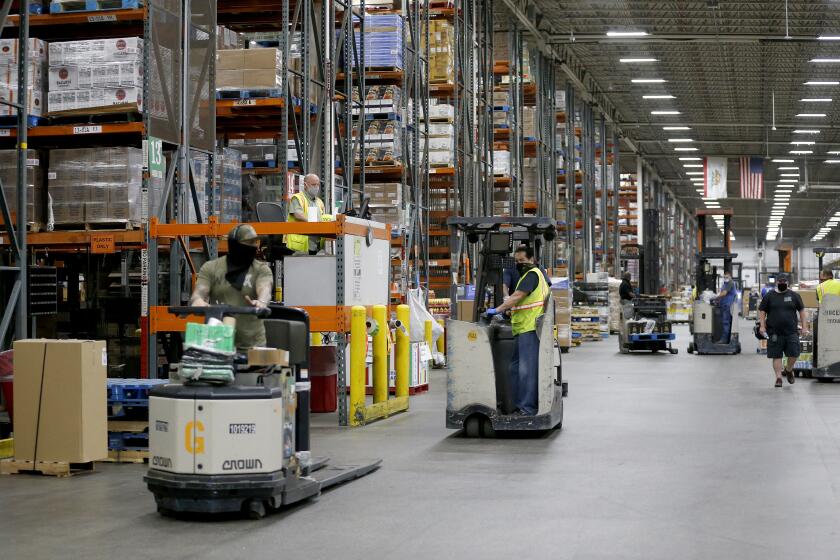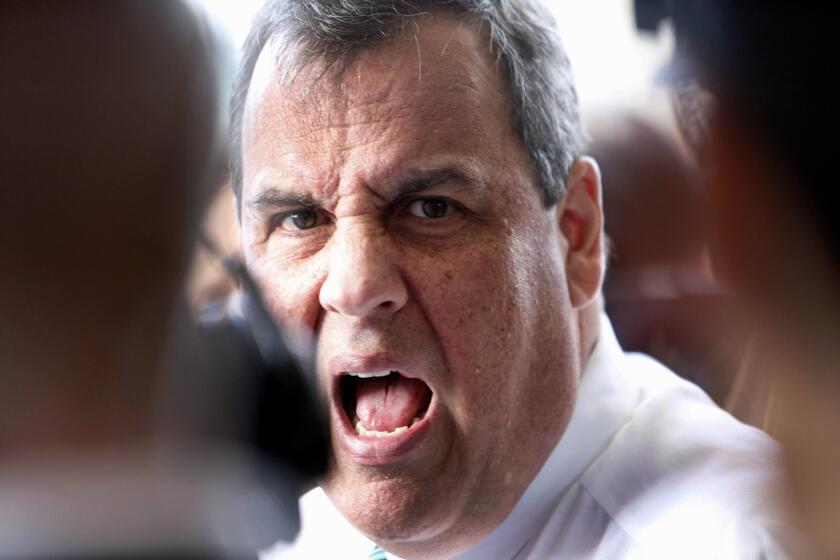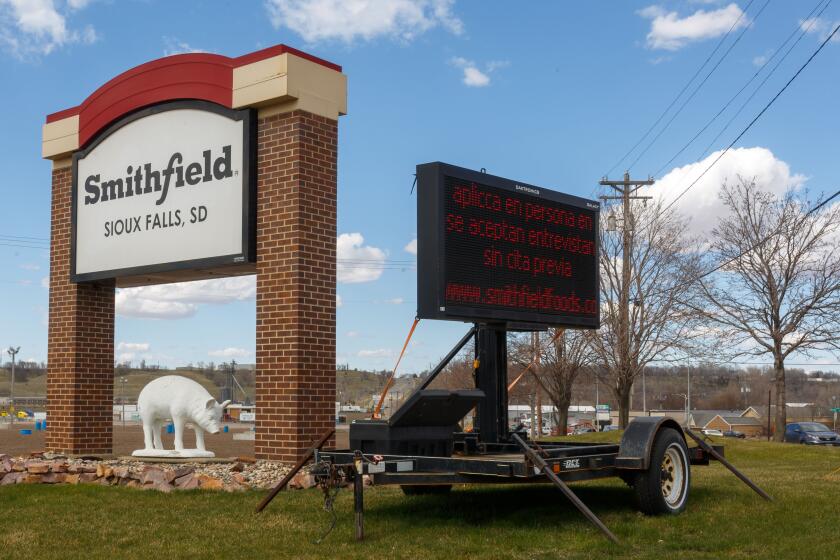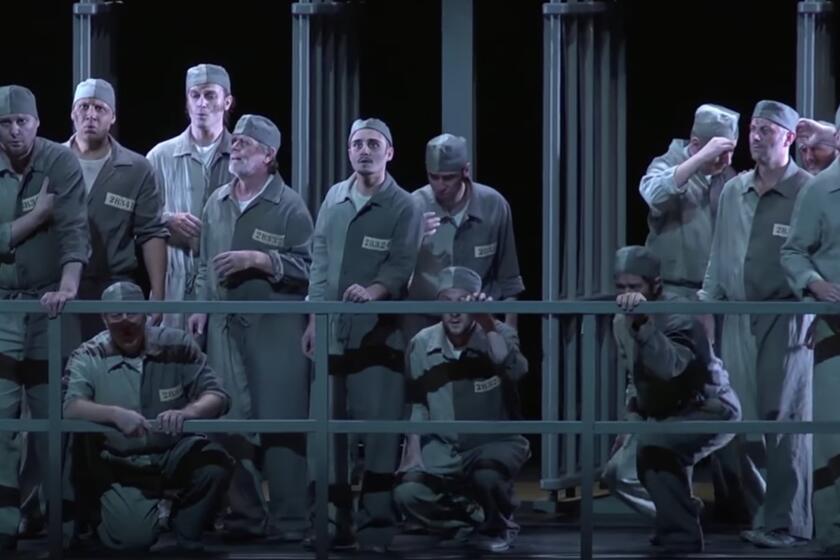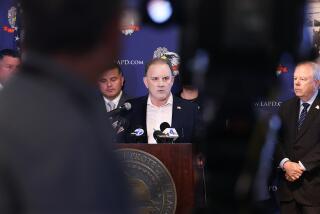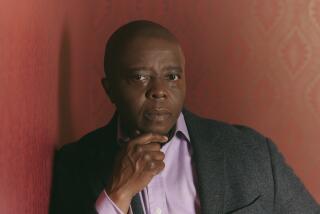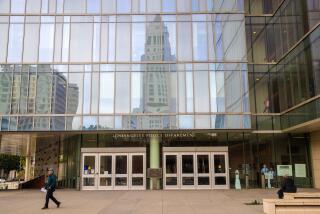Column: Police unions and military hardware fueled violent response to protesters
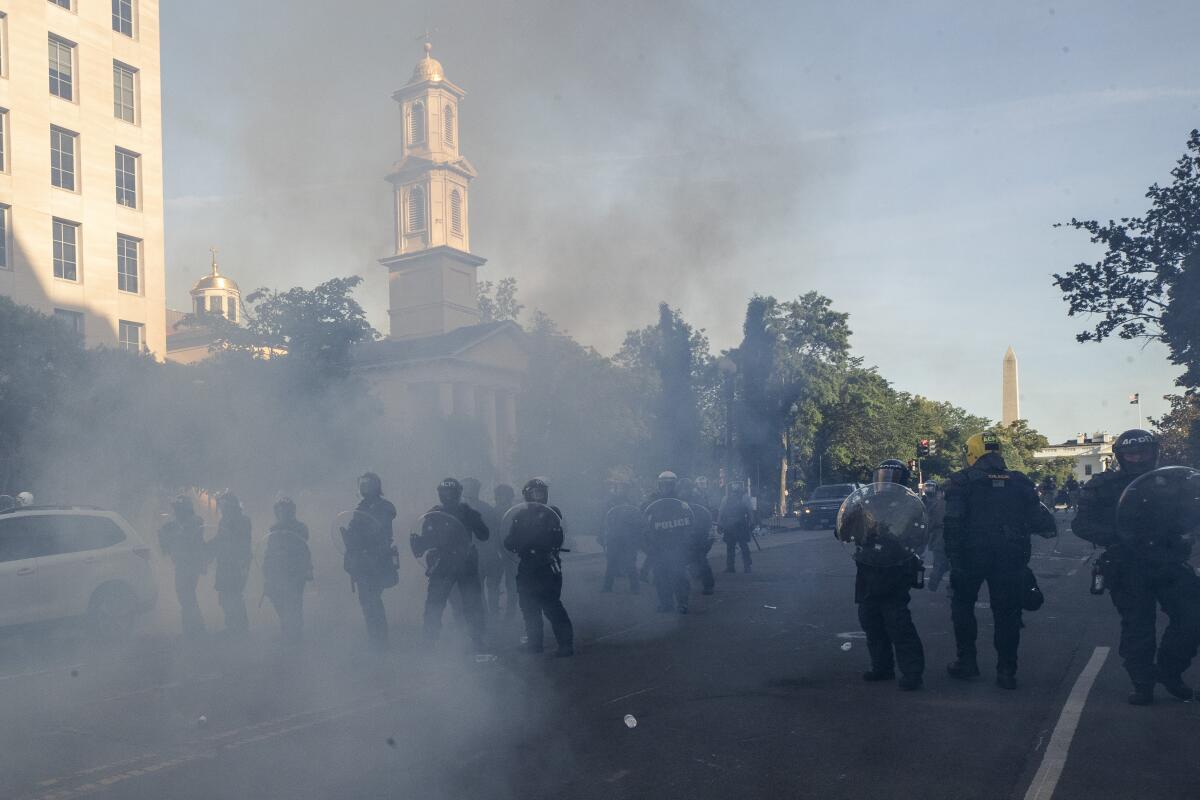
They donât look like the police on traditional patrol: helmeted and protected by bulletproof vests, firing tear gas canisters and flash grenades from behind Plexiglas riot shields, accompanied by mine-resistant armored vehicles as they advance in military order upon street demonstrators .
But they are police. Theyâve been equipped with military hardware and trained to treat every outbreak of civil disorder as if itâs tantamount to a terrorist attack. And theyâve often been shielded from discipline and oversight by union contracts granting them procedural protections they might not accept if granted to criminal suspects.
The result has been a string of violent attacks by law enforcement officers on civilians peacefully demonstrating against police brutality and racism â creating a flood of graphic images and videos on social media, cable news channels and newspaper web pages.
Weâre at a moment right now where so many more things are possible than we imagined three weeks ago.
— Karen Sheley, ACLU of Illinois
There are signs that the May 25 death of George Floyd while in the custody of Minneapolis police has triggered a decline in public trust and support for police beyond communities of color, where trust has often been low. The militaristic response to protests has not helped.
The spotlight has been focused as never before on two contributing factors in the evolution of local police into quasi-military forces: union contracts that delay and complicate discipline and oversight, and a flood of battlefield equipment provided by the Defense Department to police forces ill-trained to deploy it, but incentivized to use it in civilian communities.
House Democrats have introduced a bill that would make it easier to pursue complaints of police misconduct in court and pare back the distribution of military weaponry. Senate Republicans are working on another version.
âPeople see that this issue is not an issue that only affects, and should only be responded to, by Black people,â Rep. Karen Bass (D-Los Angeles), chair of the Congressional Black Caucus, told my colleagues Jennifer Haberkorn and Sarah D. Wire. âThat really pushes the country to an inflection moment where maybe we can actually accomplish something significant.â
Police unions, like other public sector unions, have retained their strength even as private sector unions have slid in stature. But theyâre increasingly seen by other unions as outliers in the labor movement â as obstacles to social reform and racial equality, rather than supporters of those goals.
That has produced a split among major unions affiliated with the AFL-CIO. The Assn. of Flight Attendants passed a resolution on June 5 calling on police unions to âimmediately enact policy to actively address racism in law enforcement and especially to hold officers accountable for violence against citizens, or be removed from the Labor movement.â The resolution cited approvingly a Seattle-area labor coalitionâs demand for the Seattle Police Officers Guild to move to stamp out âsystematic racismâ in its ranks or be kicked out of the coalition.
Among other AFL-CIO member unions calling for the ejection of police unions is the Writers Guild of America-East, which voted Monday to ask the AFL-CIO to expel the International Union of Police Assns. on grounds that police unions âwield their collective bargaining power as a cudgel, preventing reforms and accountability.â
But public opinion may already be writing police unions out of the labor movement. A group of civil rights organizations and other public advocates has publicly called on the AFL-CIO to expel the IUPA. The advocates asserted that as they have âfought to equalize the playing field, the one voice that obstructed reform â through vicious attacks and fear mongering tactics â has been the police unions.â
In Los Angeles, as my colleague Emily Alpert Reyes reports, local politicians have started to shun contributions from the local police union, the L.A. Police Protective League, which they once welcomed by the millions of dollars.
These actions place AFL-CIO leaders in a tight spot, since the police unions can point to procedural protections for the members as the product of collective bargaining, which organized labor hardly wishes to undermine. AFL-CIO President Richard Trumka declared recently that his preference is to âengage with our police affiliates rather than isolate them,â adding: âCollective bargaining is not the enemy.â
Concerns that union contracts have erected walls of unaccountability around police misconduct have been rising for years. A 2017 study of 178 police union contracts by criminal law expert Stephen Rushin found that nearly 90% included at least one provision that âcould thwart legitimate disciplinary actions against officers engaged in misconduct.â
Those provisions included limits on anonymous complaints, delays of as long as 10 days before an accused officer could be interviewed, restrictions on consideration of prior discipline, and limits on civilian oversight. About half of the contracts allowed disciplinary records to be expunged after a certain period.
Not all the provisions are controversial or unfair. Some contracts guarantee accused officers the right to counsel or protection against abusive interrogations. But of provisions requiring that accused officers be provided with witness statements and other evidence before they can be questioned, Rushin observed: âMost experienced police officers would balk at such hindrances to their ability to interrogate criminal suspects.â
Police unions have been especially adept at shielding members from public scrutiny, as Katherine J. Bies, currently a law clerk for a federal appeals court, observed in a 2017 study. The unions stand in the way of reforms that would âreplace secrecy with accountability and transparency,â she wrote, ascribing their power to their ability to âstrategically frame any opposition to their agenda of secrecy as endangering public safety and harming the public interest.â
Police union leaders have been stepping up their fight against change. âOver the last several years, thereâs been a shift deeper into rhetoric against reform from police union presidents,â says Karen Sheley, director of the police practices project at the ACLU of Illinois.
But while the rhetoric has become âfrankly more dangerous,â she says, union policies have remained the same â make it harder for civilians to bring complaints about police behavior, and easier for officers to avoid being brought to account.
That rhetoric has become even more heated in recent weeks, as union leaders speak out in defense of members facing discipline or criminal charges in connection with alleged assaults on demonstrators.
Hoover also ordered an attack on peaceful protesters -- and lost the presidency.
Bob Kroll, head of the Minneapolis police officers union, called Floyd a âviolent criminal,â and complained that the four officers who were present when he died were fired âwithout due process.â (Floyd had served time for aggravated robbery, but was not being stopped for a violent crime. Nor was he armed or acting violently at the time of his arrest.)
Some union leaders acknowledge that the attacks on demonstrators could undermine public support for the police.
âWe led the statewide effort through legislation for California to require that all police agencies have a minimum-use-of-force policy and to address things like de-escalation, and a duty to intercede when you see a fellow officer engaging in excessive use of force,â Robert Harris, a board member of the L.A. Police Protective League, told me. The rules were enacted last year.
Employersâ gratitude for their âheroâ workers didnât last long
âThe bedrock of interactions between police and our communities is mutual respect and trust,â Harris says. âWhen the perception is that law enforcement is the problem, thatâs dangerous.â
That brings us to the other side of the misconduct coin: placing battle-ready equipment in the hands of officers without adequate training or oversight.
The militarization of police was rooted in the war on drugs of the 1980s and 1990s. It originated in Section 1033 of a 1989 defense budget measure, which authorized the Defense Department to donate surplus military equipment to local law enforcement agencies for âcounterdrug activities,â later expanded to include âcounterterrorism activities.â
While the equipment was free, local forces had to pay for its transport and maintenance. They were also required to put the equipment to use within a year, creating a powerful incentive for police departments to deploy assault weapons and armored vehicles in civilian neighborhoods.
As the American Civil Liberties Union observed in a June 2014 report, American policing had become infused with âweapons and tactics designed for the battlefield.â The impacts of the trend were disproportionately visited on people of color, and had taken place âin the absence of any meaningful public discussion.â
The ACLU report was prescient. That August, only weeks after its publication, the city of Ferguson, Mo., erupted in protests and riots over the shooting of Michael Brown, a Black resident, by a white police officer.
The America that condones mass murder of children is allowing the coronavirus to spread.
Video reports in real time showed police shooting tear gas and rubber bullets at demonstrators, delivering to the American public a graphic display of militaristic tactics.
Once police had such equipment in hand, they were generally inclined to put them to use anyway.
Workers crammed virtually shoulder-to-shoulder to tend production lines moving at inexorable speeds, high rates of disease and injury, low pay and unforgiving rules on time off or meal and bathroom breaks. Descriptions of todayâs meatpacking industry sound lifted from Upton Sinclair.
âAs agencies get more militarized, they may start to use the means of violence more often,â Ryan Welch, an expert in the program at the University of Tampa, told me. âItâs the law of the instrument: When you have a hammer, everything looks like a nail.â
The incursion of paramilitary tactics into local policing was popularized by the creation of the LAPDâs SWAT (Special Weapons and Tactics) teams by the departmentâs future chief, Daryl Gates, in the years following the 1965 Watts Riots.
SWAT teams soon came to be deployed beyond special situations. They became common in the execution of search warrants, especially in drug cases.
Almost always they were unnecessary. In a 2018 paper, Princeton political scientist Jonathan Mummolo determined that more than 91% of SWAT deployments in Maryland in 2010-2014 were for search warrants. Fewer than 5% involved barricaded suspects, in which brute force might be necessary.
The 1033 program was characterized by extreme sloppiness, with few records available about the value of equipment being sent to local departments.
The post-coronavirus reopening is up to consumers, not Trump or governors.
In 2017, the Government Accountability Office reported that it had acquired $1.2 million in military equipment through a fictitious agency it had created to test the Pentagonâs control of where its surplus goods were sent. The hoard included ânight vision goggles, simulated rifles, and simulated pipe bombs, which could be potentially lethal items if modified with commercially available items,â the GAO said.
President Obama banned the transfer of some equipment in 2015, including tracked armored vehicles, grenade launchers, bayonets and large-caliber weapons and ammo. He also required that the receiving agencies train their personnel in the use of transferred weapons and set rules on when they could be deployed against civilians.
But Obama left much of the 1`033 program in place. When Donald Trump took office in 2017, he rescinded Obamaâs limitations. The House police reform bill would restore them.
A recent poll from the Washington Post and George Mason University found that in the few weeks since the death of George Floyd, Americans have come to recognize that racism is institutionalized in policing and more needs to be done to eradicate it.
âWeâre at a moment right now where so many more things are possible than we imagined three weeks ago,â says Sheley. âCries for justice are going to be heeded, because if theyâre not there are going to be political consequences.â
More to Read
Inside the business of entertainment
The Wide Shot brings you news, analysis and insights on everything from streaming wars to production â and what it all means for the future.
You may occasionally receive promotional content from the Los Angeles Times.
